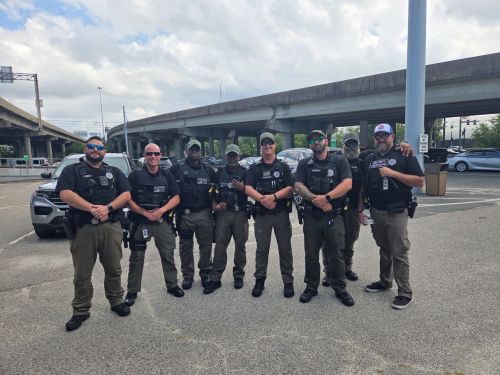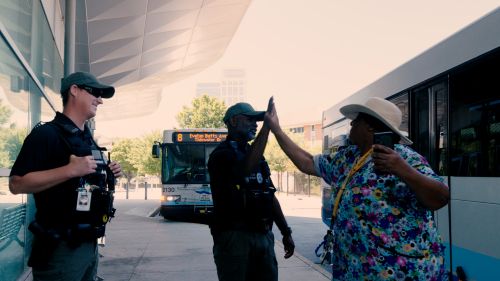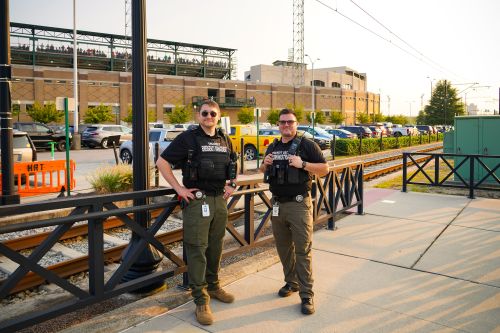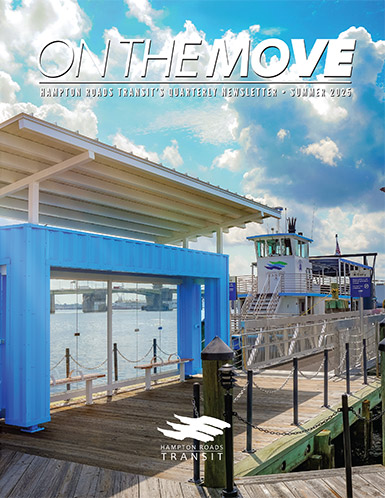Transit Security Teams Protect Riders and Employees – Here’s How
Hampton Roads Transit (HRT) takes seriously the safety and security of its employees and customers. It’s our mission and among our core values. That is why, for the past several years, HRT has been growing its security team with plans for further expansion.
“I have two customers,” said Shane Kelly, HRT’s Senior Manager of the Department of Security Services. “The HRT patron and the HRT employee.”
When Kelly joined HRT in 2019, security had just split from the Safety Department, and he was a team of one. That’s a “heavy lift” for an agency of 1,000-plus employees, said Benjamin Simms IV, HRT’s Chief Transit Operations Officer. Slowly, the department has grown and now includes an assistant manager and supervisor, all overseeing a team of transit security officers (TSOs).
“HRT has invested an incredible amount of time and resources into starting an internal [security] program that’s niche and dedicated to working with the transit system’s needs,” said Kelly.
One change the agency implemented was moving away from contracted security to creating its own internal team. It’s paying dividends.

“Hiring the first two TSOs was the biggest hurdle,” Simms explained, “because we had to have buy-in from the CEO, legal, human resources, and safety.” After those two initial officers were hired and everyone began to see the benefits of having them on staff, Simms said it was easier to bring others on board. “There were a lot of ‘what ifs’ we had to get over for everyone to be comfortable,” Simms recalled.
“It’s better to have someone on the team who is invested in the organization because they are an employee of the organization,” Kelly said.
Guarding the system
When HRT was formed in 1999, there was no security program in place. Kelly says that created opportunities for people to take advantage of the system without repercussions. His goal, since coming on board, has been to change that. Kelly and Simms would both like to see HRT’s TSO program transform into a transit police authority.
“Having internal people who are task-oriented and dedicated to the transit system and security needs is worth continuing to expand to effectively deter behavior,” Kelly explained.
The brutal stabbing of a woman on a light rail train in Charlotte, N.C., grabbed headlines this summer – thrusting the safety and security of public transit onto the national stage. Despite what happened in Charlotte, public transit is still one of the safest ways to travel. According to Todd Litman, founder and executive director of the Victoria Transport Policy Institute, the risk of death or injury on public transit is about one-tenth that of car travel.
While crime increased overall post-pandemic, data from the U.S. Department of Transportation shows “security events on public transit fell sharply in 2023 and 2024.” New York’s Metropolitan Transportation Authority (MTA), the largest public transit system in the U.S., has just reported that subway crime fell to a record low this summer.
Among the many things MTA did to achieve success was adding more officers to its trains, installing more security cameras, and improving the lighting at subway stations. It came with a price tag of $77 million – all funded by the state of New York. Clearly, the answer to increasing public transit safety and security isn’t reducing public transit funding.
HRT partnered with the City of Norfolk, the Norfolk Tides, and Norfolk State University to provide free public transit on game days to Harbor Park and Dick Price Stadium. It’s proved to be a successful partnership, with park-and-ride lots, light rail stations, trains and ferries packed with people heading to and from games. It’s all hands on deck for HRT’s security team.
“I can’t tell you how many people that we’ve spoken to, employees as well as customers, who are so thankful for [security] being out there,” Kelly said.
That’s exactly what Operations wants to hear.
“We want customers to feel comfortable and safe using any of our modes of transportation,” Simms said.

See something, say something
While the team is growing, Kelly emphasized, “we can’t be everywhere.” He says the community – and HRT passengers – also have a role to play in keeping the system secure. Simms could not agree more. He says we can’t have a “not me” attitude.
“Safety and the well-being of others as well as ourselves is all of our responsibility,” Simms said.
“People’s behavior and what they expect of each other and themselves matter,” Kelly said. “There’s always going to be more of them than there are of us.”
Kelly says what customers see and say is important. He encourages riders to be more than just a customer; be a stakeholder.
One of the agency’s biggest challenges, especially this time of year, is how best to navigate an unhoused population making use of its many bus shelters. That’s not a public transit problem. That’s a much larger community issue.
“They obviously have a need that society isn’t meeting,” Kelly said.
His team collaborates with agencies, such as the local community service board, to connect them with resources and help them find housing.
Bottom line – HRT has done a good job of looking inward and making changes. However, Kelly says, “there’s room to grow.”
“Change doesn’t happen overnight,” Kelly said. “And you can’t do it without dedicated people.”






